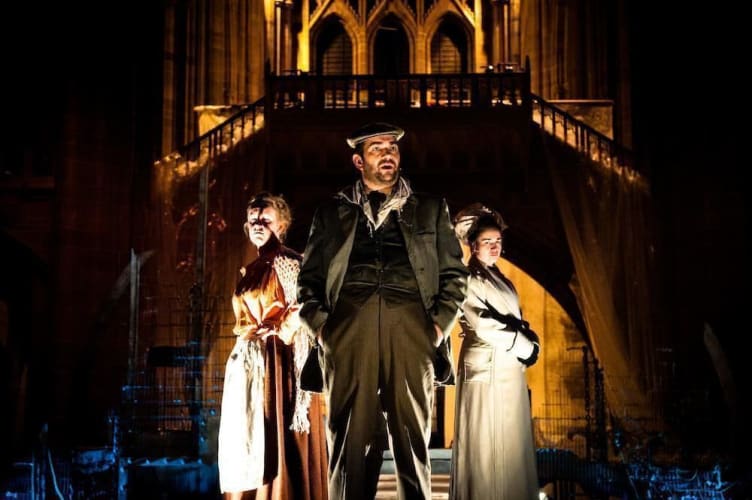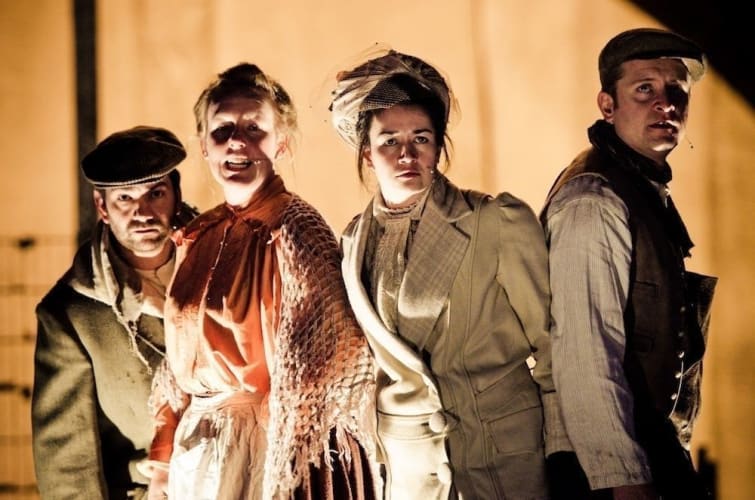To stage a mixed media production telling the story of the Titanic in a cathedral. You can see how the idea and its possibilities must have set the pulse racing for creator / director, Jen Heyes.
The audience are guided to their seats via the doors of the Lady Chapel, proceeding across a gangway as though boarding the ship. Along this journey, we encounter a series of tableaux: an archivist, engrossed in a ledger and surrounded by boxes of documents marked “Titanic”; a woman staring forlornly at a pair of girl’s shoes, set in a box like a tiny shrine. Ahead and above, a lone man in uniform stands gazing out, as if on the bridge of a ship, whilst, lurking in the shadows to our left, another man almost in darkness, sits “reading” a newspaper, heaps of abandoned luggage nearby.
All this and the ambient music (think New Age from the depths of the ocean) combine to good effect, establishing a sense of loss and melancholy, highly pertinent to the subject matter. A good launch but we are not yet in open waters.
The first problem is small yet significant. As there is nowhere big enough for us all to assemble pre-show, the audience enters piecemeal over a period of twenty to thirty minutes. Thus the mood created by the ‘journey’ dissipates well before the main performance begins. A pity.
The real challenge facing the makers of Treasured, however, only becomes apparent as we settle into our seats; it is the soaring magnificence of the architecture. Think about it—a show about the Titanic, staged in a titanic building. The audience are entitled to expect wonders. The production simply must live up to its setting.
There are moments when it seems that Treasured almost has this daunting goal within its grasp. Ailís Ní Ríain’s music is well-tuned to both mood and environment. This is particularly true when Brendan Ball’s solo trumpet first enters and is permitted to make full use of the acoustic space.
But the cathedral’s six second reverberation, which is such a gift to composer and musician, proves an all but mortal blow to the actors. As their own amplified words bounce back at them from the unyielding stone surfaces of the cathedral, much of the dialogue is drowned beneath the waves of their echoing voices.
Perhaps it is awareness of this (a sound engineer’s nightmare) which prompts many of the cast to tell their stories in subdued tones. Or perhaps this was a directorial choice—we are, after all, listening to the dead.
Despite this, it is Christopher Hollinshead who gives the standout performances of the evening as Mattie and Seanie; the former a proud shipbuilder at Harland and Wolff in Belfast; the latter, a brash adventurer from Cork, who persuades his homesick pal, Pat (Brian Dodd) that an ocean crossing on the Titanic is the opportunity of their lives. Hollinshead bravely takes on the acoustics with passion and energy, and we make the extra effort to decipher his words, because he endeavours to draw us into the moment.
This is where Ríain the writer too often makes the wrong choice. The history of the Titanic is so packed with jaw-dropping facts and memorable tales that it is understandable (if not forgivable) that she should be seduced by her research. A writer must discipline herself to make tough choices—reveal this amazing statistic, but leave out that one; tell one gripping story but remain silent on another. And, above all, when you have an audience sitting on the bottom of the ocean facing the “bones” of the doomed liner, drag us into the moment and keep us there.
Too often, the monologues in Treasured have characters telling us what did happen rather than what is happening. We need to be with Fred Fleet when he spies the giant iceberg and raises the alarm, not when he is recounting the incident to an investigative committee. If your characters are distanced from the emotion of the event, so will be your audience.
The production could pay greater homage to the son et lumiére tradition, especially with respect to son. Why, for example, give us a list of names (projected and recited) to illustrate the range of nationalities aboard ship? Liverpool remains so international a city that the voices of those nations—Swedish, Finnish, Croatian, Polish, Chinese etc, etc—could themselves have been invited to testify to this Ship of Babel.
There is a single moment of ‘wired aerial theatre’ in the show, which is powerfully and beautifully executed, but, in isolation as it is, it does not enhance the whole as effectively as a restrained but properly integrated use of this art form might do.
Not all of the projections are entirely successful. However, the two representing the ocean liner at sea are truly stunning and provide a tantalising glimpse of the epic event this show might have been.
The script notes that the ‘ego grows wild if un-tethered by humility.’ This might well speak truly of engineering technology, but great art often requires the untethering of ego... and of the creative imagination.


